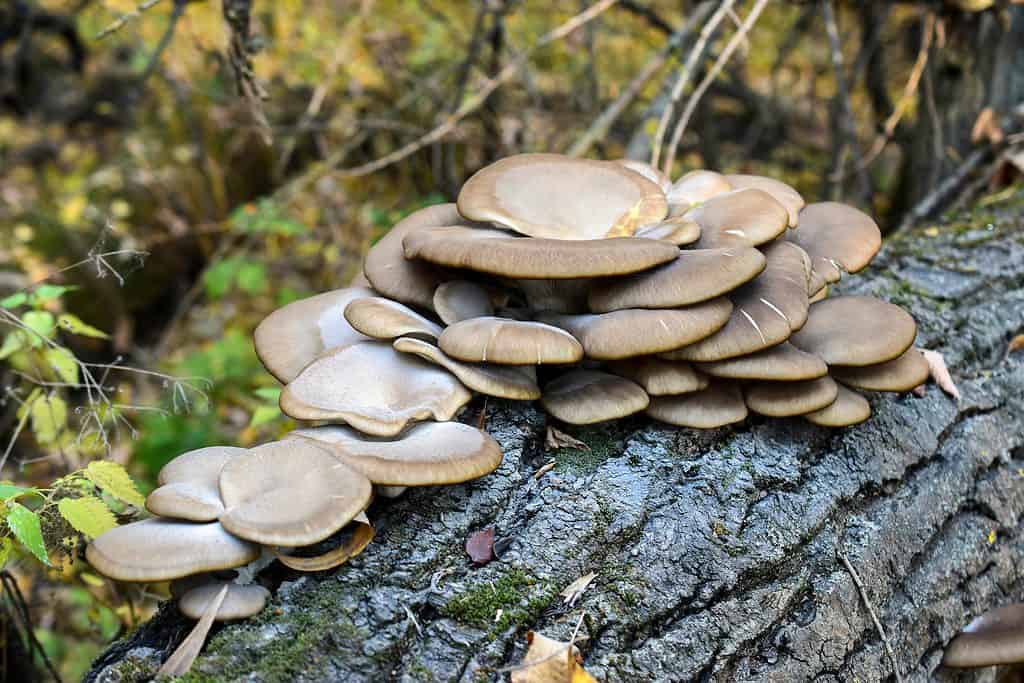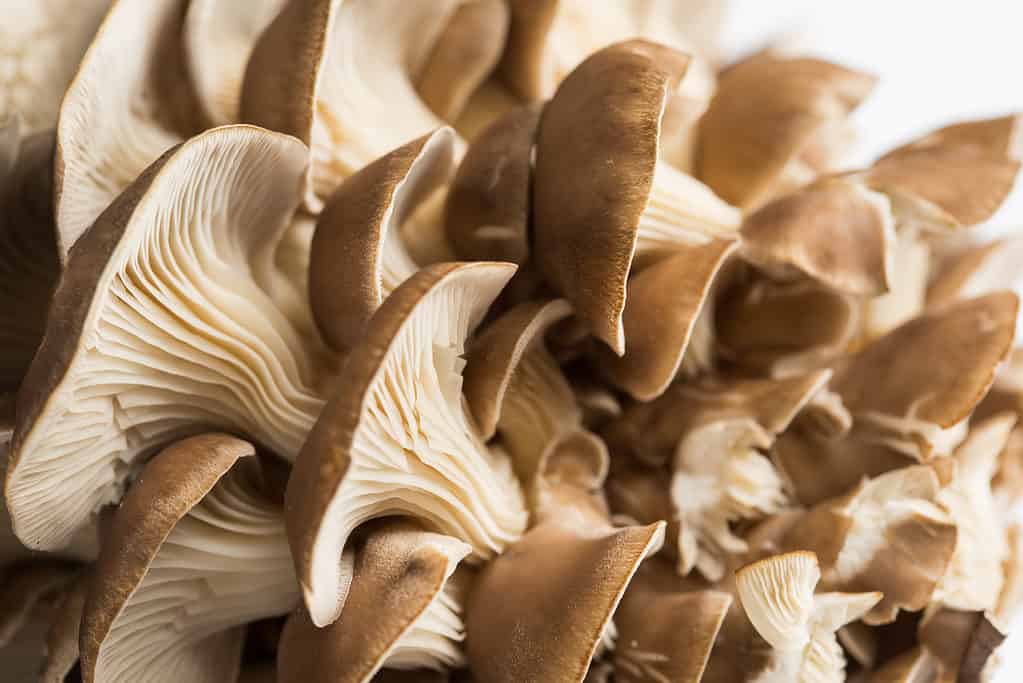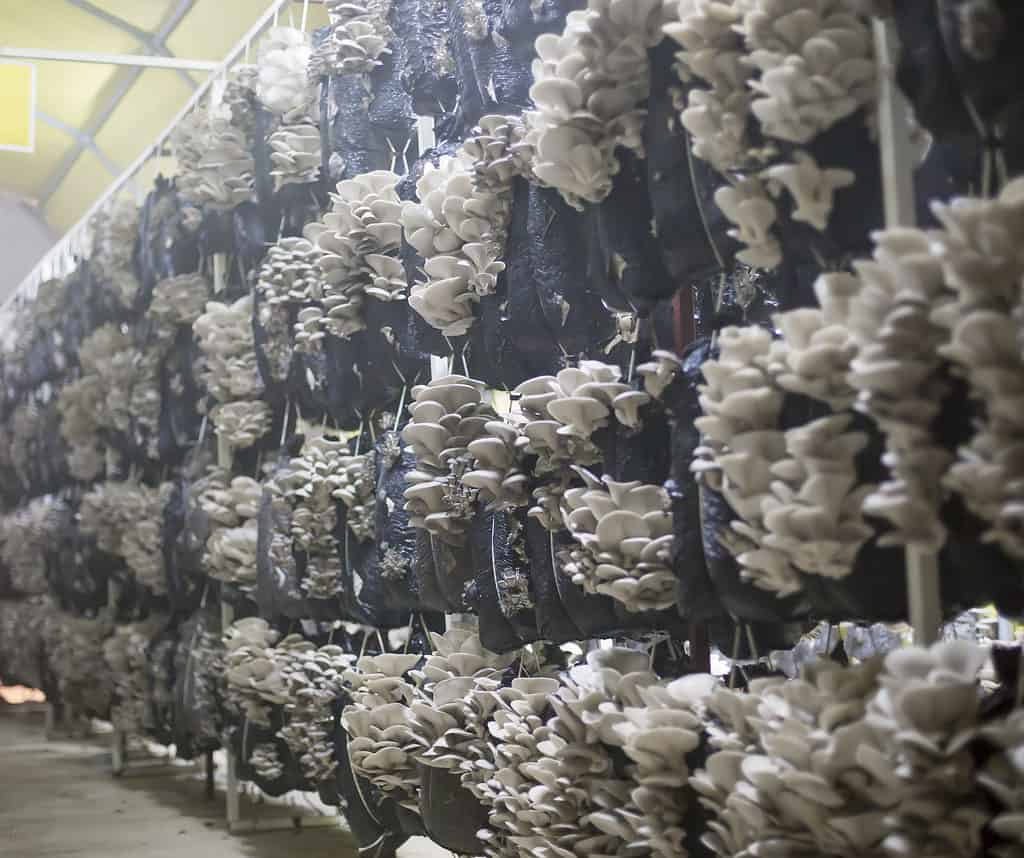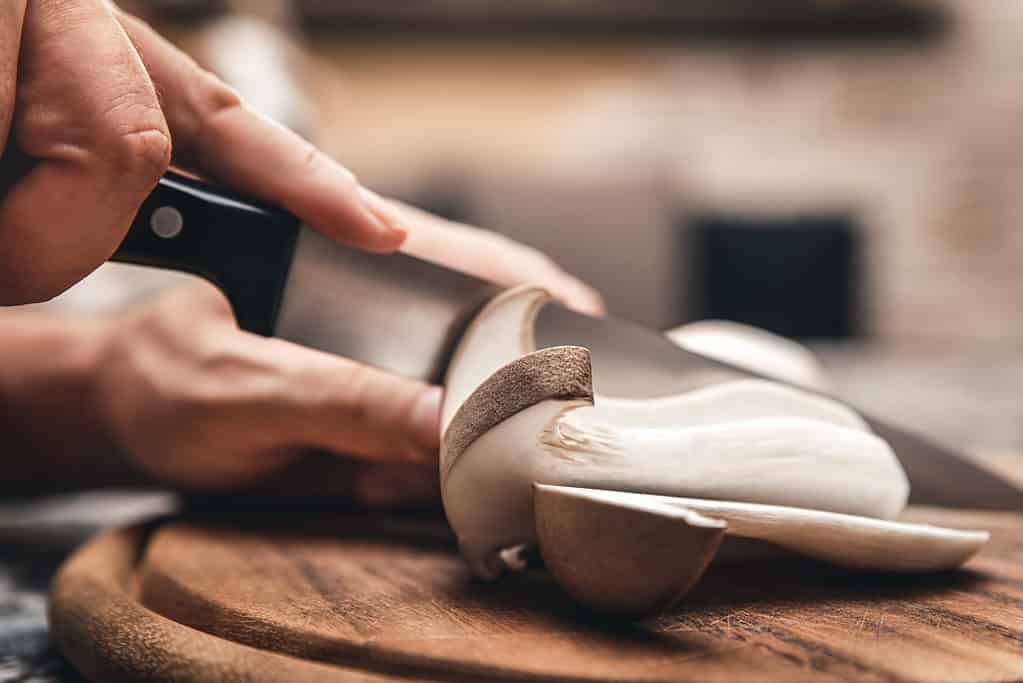You may know that some mushrooms can be meat replacements because of their meat-like texture and umami flavor. But did you know that some mushrooms have a briny flavor reminiscent of seafood and texture like that of shellfish? In fact, there is a mushroom that is served as an alternative to seafood dishes! They are the oyster mushroom, Pleurotus ostreatus, and the king oyster mushroom, Pleurotus eryngii.
- Both mushrooms are both members of the Pleurotus genus and are referred to as “oyster mushrooms.”
- Both are gilled mushrooms that grow on dead wood in forest environments.
- Both are edible and have a pleasant, seafood-like taste.
- Oyster mushrooms are more common and widely-consumed.
- King oyster mushrooms have a stronger flavor and unique texture more close to that of real seafood.
This article compares and contrasts the oyster mushroom with the king oyster mushroom so that you can learn the main features of each. By the end, you should know key details about both species, including how and where they grow, their appearance, how they taste, and what you can use them for. Let’s dive in and learn about these two oyster mushroom species together!
Oyster Mushrooms vs. King Oyster Mushrooms
| Characteristic | Oyster Mushrooms | King Oyster Mushrooms |
|---|---|---|
| Scientific Name | Pleurotus ostreatus | Pleurotus eryngii |
| Genus | Pleurotus | Pleurotus |
| Family | Pleurotaceae | Pleurotaceae |
| Division | Basidiomycota | Basidiomycota |
| Kingdom | Fungi | Fungi |
| Common Name | Oyster mushroom, oyster fungus, hiratake, pearl oyster mushroom | King oyster mushroom, king trumpet, French horn mushroom, eryngii |
| Origin | Asia, Europe, North America | Europe, North Africa, Western Asia/Middle East |
| Description of Fungus | Oyster mushrooms grow in an oyster or fan shape, typically in shades of white, brown, or gray, though some varieties appear in other colors. Oyster mushrooms grow on the sides of dead trees or wood, and are a widely-cultivated edible mushroom. Oyster mushrooms have cream-colored gills, short stems, and flat caps. They range in size, but are typically medium to large, with caps that grow to be between 2 and 10 inches across. Their stems are tough and woody. | King oyster mushrooms are the largest of the so-called “oyster mushrooms” in the genus Pleurotus. King oyster mushrooms grow on dead or decaying hardwood tree species. They are large in size, with caps that can reach up to 8 inches across and 2 inches thick. The white or cream-colored gills run most of the way down the stem. These mushrooms have brown caps and white stems. Their stems are edible and sometimes said to taste seafood-like or similar to scallops. |
Descriptions of Oyster Mushrooms and King Oyster Mushrooms
Oyster Mushrooms

Oyster mushrooms have a dense, meaty, and chewy texture.
©LeManilo/Shutterstock.com
The oyster mushroom is the species Pleurotus ostreatu. This is a species in the genus Pleurotus, which contains 26 other species of mushrooms, many of which are edible. Sometimes multiple species within the genus are referred to as “oyster mushrooms.” However, Pleurotus ostreatu is the most well-known and commonly cultivated species in the genus. Oyster mushrooms have gray, white, or brown caps that grow in a fan-like or oyster-like shape. It is this coloring and shape that inspired the name! Some people think that the mushroom bears a resemblance to the real oysters that come from the ocean. Oyster mushrooms can be found growing in forest environments. There, they appear on dead or decaying hardwood tree species, often in groups.
Today, oyster mushrooms are one of the most commonly consumed and widely cultivated mushroom species. Though they are originally from the Middle Eastern region (parts of Europe, Asia, and North Africa), they are now grown in multiple parts of the world and are especially popular in Asia. Though oyster mushrooms may be foraged from the wild, they are also relatively easy to cultivate, which contributed to their widespread commercial cultivation and the rise in starter kits for amateur cultivators to try at home.
Oyster mushrooms are said to have a slightly seafood-like taste. Their dense, meaty, and slightly chewy texture and “briny” flavor make them a beloved addition to soups, sauces, and stews. You will see them appear frequently in many recipes for cooking Asian cuisines. Some report that oyster mushrooms have a slightly fishy scent. Others say that it emits an aroma that is licorice-like or similar to the smell of anise.
King Oyster Mushrooms

The common name for
Pleurotus eryngiiis king oyster mushroom.
©Miriam Doerr Martin Frommherz/Shutterstock.com
The king oyster mushroom is the species Pleurotus eryngii. The king oyster is also a member of the Pleurotus genus along with the more well-known oyster mushroom, Pleurotus ostreatu. At times, you may hear it referred to as an “oyster mushroom,” a “French horn,” or a “king trumpet.” King oyster mushrooms are typically much larger than oyster mushrooms, grow in more of a cylindrical shape, and have a smooth outside texture. Their stems are thick, meaty, and white or cream-colored, while their caps are brown. Like oyster mushrooms, you can find them growing near dead or decaying trees. However, they typically grow individually, while oyster mushrooms often grow in clusters. They also grow in the soil near the roots of trees, rather than as a shelf formation on the side of wood.
Though king oyster mushrooms have not reached the same level of popularity as oyster mushrooms, they are also a popular ingredient, particularly in Asian cooking. Like oyster mushrooms, king oysters are originally from the Middle East or Mediterranean region and are found natively in parts of Europe, Asia, and North Africa. However, they are cultivated around the world and can be grown at home by amateur mushroom cultivators.
While the stems of oyster mushrooms are not pleasant to eat, the stems are the best part of the king oyster mushroom! While there are some similarities between the two mushrooms and king oysters also have a seafood-like taste and chewy texture, the king oyster mushroom may be even more savory, with the texture being even meatier.
Key Differences
Though oyster mushrooms and king oyster mushrooms are both edible mushroom species in the same genus, which grow in similar parts of the world and are often described as having a similar flavor profile and texture, there are also several ways in which they are different. The descriptions above begin to describe some of these differences in appearance, flavor, texture, and use. However, they also possess unique histories and cultivation needs. Let’s explore these key differences in greater detail now.
History and Origins
Oyster Mushrooms
Today, oyster mushrooms are widely cultivated for human consumption. They are relatively easy to grow, so you can even try cultivating them at home! Oyster mushrooms first gained popularity in Germany during World War I. During this time period, food shortages led people to begin cultivating alternative sources of food, especially ones that are nutrient-dense, like mushrooms. After World War I, oyster mushrooms rose in popularity as a cheaper, nutritious alternative to meat. Because they have a chewy, meat-like texture and strong umami flavor, they make a robust addition to soups or other dishes. In the 21st century, oyster mushrooms are second in popularity only to Agaricus bisporus, the most widely-cultivated mushroom species. Agaricus bisporus is the species of white button mushrooms, cremini or baby bella mushrooms, and portobello mushrooms (with the name varying by the mushroom’s stage of maturity).
Oyster mushrooms are particularly popular in Asia, where China leads the world in oyster mushroom farming. China farms approximately 85% of the world’s oyster mushrooms. Other countries follow in production, with Korea, Japan, Taiwan, Thailand, and the Philippines being other top oyster mushroom producing countries – though they own a much smaller share of the market than China.
King Oyster Mushrooms
Like oyster mushrooms, king oyster mushrooms are native to the Middle East/Mediterranean region, where they have been grown since ancient times. People started commercially cultivating king oyster mushrooms much more recently, with one of the most popular variations of king oyster mushrooms introduced to Japan in the 1990s. However, since then, king oyster mushroom cultivation has taken off. Like in the case of the oyster mushroom, multiple countries in Asia lead the world’s production of king oyster mushrooms. Some of the top producers are China, South Korea, and Japan, with China estimated to produce approximately 65% of the world’s supply.
Appearance
Oyster Mushrooms

Fan-shaped caps growing off of the side of trees indicate oyster mushrooms.
©Tiplyashina Evgeniya/Shutterstock.com
Oyster mushrooms are medium or large in size. Some caps grow as big as 10 inches in diameter! Pleurotus ostreatus typically has fan-shaped or oyster-shaped caps that grow off of the side of fallen or standing trees. These caps have grooves, ridges, and bumps, and tend to come in shades of brown or gray, though other species of oyster mushrooms come in a range of colors, including white, blue, and pink. Oyster mushrooms have short stems and cream-colored gills, which fall along the stubby stem. You will often find that the oyster mushrooms appear in clusters that grow close together on the side of a dead tree or decaying log.
King Oyster Mushrooms

With a prominent and thick stem, king oyster mushrooms look much different than oyster mushrooms.
©Tienuskin/Shutterstock.com
King oyster mushrooms look very different. Oyster mushrooms have short or nonexistent-looking stems. The king oyster mushroom has a prominent, thick stem and flatter brown caps that form a rounded top. Their cream-colored stems are so thick and smooth that the mushrooms may appear to be cylindrical in shape. Rather than growing in crowded clusters, as oyster mushrooms do, king oyster mushrooms grow independently. They also appear in the soil at the base of trees, emerging from the soil near the roots of hardwood species, rather than growing on the side of trees.
Growing Conditions
Oyster Mushrooms
Oyster mushrooms are a saprophytic mushroom species. This means that they grow on dead or decaying trees. These mushrooms actually serve to break down the tissue of dead wood. While they feed on the nutrients from the wood, they are not parasitic because rather than attacking live tree tissue, they help to decompose the already-dead wood in the forest. In doing so, they provide an important service by helping to “clean” the forest by breaking down dead trees.
Oyster mushrooms grow on deciduous hardwood trees, though they occasionally appear on conifers. There, you will often find large clusters of oyster mushrooms growing on the side of standing dead trees or fallen logs. Look for them beginning in the spring, through the summer, and into autumn or early winter. Depending on the climate, oyster mushrooms may even grow year-round!
These are some of the easiest mushrooms to cultivate at home and grow well in cooler temperatures. If you think you may want to try growing oyster mushrooms for yourself, look into a pre-organized grow kit or research a tutorial on how to access the mushroom spawn and set up a supportive environment for it to develop!
King Oyster Mushrooms
Like oyster mushrooms, king oyster mushrooms grow in wild forest environments on dead or decaying hardwood trees. However, while oyster mushrooms are purely saprophytic and do not attack living tree tissue, king oyster mushrooms are described as slightly or “weakly” parasitic. Though they are primarily saprophytic and break down already-dead tree tissue, king oysters are sometimes found growing on the roots or stems of live trees.
Unlike oyster mushrooms, which grow in large groupings and appear on the sides of trees or wood, king oyster mushrooms grow individually. Oyster mushrooms grow in large shelf formations, extending from the side of wood. King oyster mushrooms appear in the soil at the base of trees, where they gain nutrients from the root system.
King oyster mushrooms are also more difficult to cultivate compared to oyster mushrooms. Thus they are not the ideal starting place for beginner mushroom cultivators.
Scent and Taste
Oyster Mushrooms
Oyster mushrooms have a “briny,” savory, and anise-like flavor. Though they gained their name for looking like an oyster, some people describe their taste as being subtly seafood-like, earthy, and umami. Their tender but meaty and chewy texture makes them suitable for a wide variety of soups, stews, or sauces, where they add a pleasant texture.
King Oyster Mushrooms
In comparison, king oyster mushrooms are often called “superior” to oyster mushrooms because their taste is so strongly reminiscent of certain seafood dishes. They have a similar flavor profile to the oyster mushroom, with hints of brine and anise or licorice, and a similar texture. The king oyster’s flavor is sometimes described as more complex and the texture is meat-like. While the stems of oyster mushrooms are virtually nonexistent and are not delicious to eat, the stem is the main section of the king oyster mushroom that people eat. When sliced into small rounds, this stem can serve as an alternative to certain seafood dishes – such as seared scallops. The similarities in appearance, chewy texture and salty seafood flavor have caused some cooks to call the king oyster mushroom a convincing scallop alternative.
Health Benefits and Use
Oyster Mushrooms

Oyster mushrooms provide a wide array of nutritional benefits.
©iStock.com/lenoo
Eating oyster mushrooms or king oyster mushrooms can bring many nutritional benefits. Oyster mushrooms contain fiber and minerals, such as zinc, potassium, iron, niacin, choline, and folate. They give you about 3 grams of protein per cup and also provide some amount of vitamin D and selenium. Some researchers have found evidence that eating oyster mushrooms can boost your heart health, regulate your blood sugar, and promote a healthy immune system.
In addition to the health benefits, many people incorporate oyster mushrooms into their diet because of the mushrooms’ tender, meaty texture, and subtle flavor. They are especially popular in Asian dishes, especially in countries such as China, Japan, South Korea, and Thailand, where they make appearances in many soups, stews, or stir-fry dishes.
King Oyster Mushrooms

Many cooks use king oyster mushrooms as an ingredient in dishes.
©Miriam Doerr Martin Frommherz/Shutterstock.com
King oyster mushrooms also offer various nutritional benefits, as they are a great source of fiber, potassium, copper, niacin, and other nutrients; are a good source of protein; and contain relatively high amounts of iron, magnesium, zinc, and vitamin B6. Some research suggests that they can help lower your cholesterol and have similar effects in boosting your immune system as oyster mushrooms do.
King oyster mushrooms are often pan-fried, added to soups, or incorporated in salads. Because they are sometimes called a vegan or vegetarian alternative to traditional seared scallops, you can prepare a king oyster mushroom in a similar fashion by slicing it into small disks and pan-searing them in butter or oil to bring out a pleasant chewy texture and umami flavor.
In Summary
As we have learned, oyster mushrooms and king oyster mushrooms are members of the same genus and are both edible mushroom species that can bring a unique seafood flavor to your cooking. However, they are different from each other in several ways: their appearances, where they grow, the robustness of their flavor, how they are used, and how easy they are to grow. Keep these in mind so that you can identify each one. Consider trying each in your next recipe or as a seafood alternative the next time you crave something from the ocean!
The photo featured at the top of this post is ©
The information presented on or through the Website is made available solely for general informational purposes. We do not warrant the accuracy, completeness, or usefulness of this information. Any reliance you place on such information is strictly at your own risk. We disclaim all liability and responsibility arising from any reliance placed on such materials by you or any other visitor to the Website, or by anyone who may be informed of any of its contents. None of the statements or claims on the Website should be taken as medical advice, health advice, or as confirmation that a plant, fungus, or other item is safe for consumption or will provide any health benefits. Anyone considering the health benefits of particular plant, fungus, or other item should first consult with a doctor or other medical professional. The statements made within this Website have not been evaluated by the Food and Drug Administration. These statements are not intended to diagnose, treat, cure or prevent any disease.
Sources
- National Horticulture Board, Available here: https://nhb.gov.in/report_files/oyster_mushroom/oyster%20mushroom.htm#:~:text=China%2C%20the%20world%20leader%20in,%2C%20Taiwan%2C%20Thailand%20and%20Phillipines.
- Business Wire, Available here: https://www.businesswire.com/news/home/20200423005608/en/Mushroom-Cultivation-Market-by-Type-By-Phase-and-By-Region---Global-Forecast-to-2025---ResearchAndMarkets.com
- MDC Teacher Portal, Available here: https://education.mdc.mo.gov/discover-nature/field-guide/oyster-mushroom
- Wildlife Trusts, Available here: https://www.wildlifetrusts.org/wildlife-explorer/fungi/oyster-mushroom
- Great British Chefs, Available here: https://www.greatbritishchefs.com/how-to-cook/how-to-cook-king-oyster-mushrooms#:~:text=The%20king%20trumpet%2C%20eryngii%20or,meaty%20texture%20and%20umami%20flavour.
- Nature.com, Available here: https://www.nature.com/articles/s41598-021-94038-2
- Science Direct, Available here: https://www.sciencedirect.com/topics/biochemistry-genetics-and-molecular-biology/pleurotus-eryngii
Thank you for reading! Have some feedback for us? Contact the AZ Animals editorial team.






